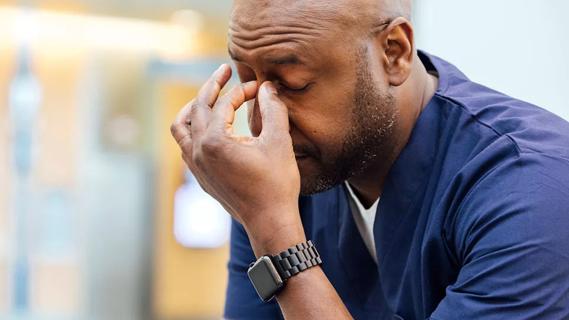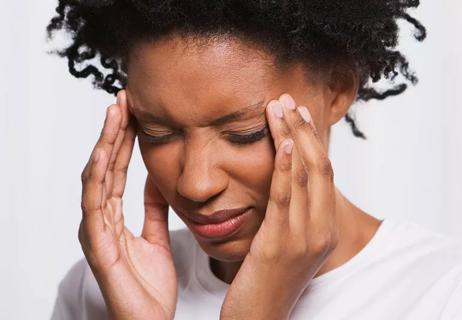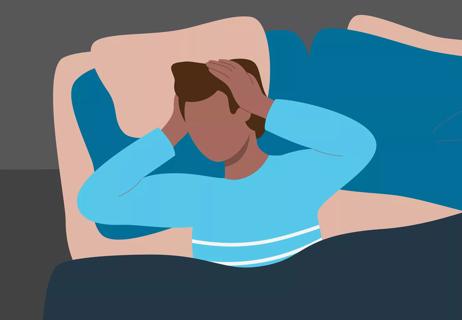Dehydration, spinal fluid leaks and other conditions can cause positional headaches when you stand up

Does your head often hurt when you stand up or get out of bed? That’s called getting a positional headache. And it’s worth paying attention to — and discussing with your provider.
Advertisement
Cleveland Clinic is a non-profit academic medical center. Advertising on our site helps support our mission. We do not endorse non-Cleveland Clinic products or services. Policy
“Head pain that comes on when you change positions is usually a symptom of an underlying condition,” says family medicine specialist Scott Owen, DO. “It’s often something simple, like dehydration. But it may be something more serious.”
Dr. Owen explains what causes head pain when standing up and when to seek medical care.
Positional headache is head pain that occurs when you stand up from a seated or prone (lying down) position. You may also hear it called a “postural headache” or an “orthostatic headache.” Orthostatic means straight or upright.
“Postural headaches are secondary headaches, meaning the head pain is a symptom of another condition,” explains Dr. Owen. Secondary headaches differ from primary headaches, such as tension headaches and migraines. Primary headaches are conditions all by themselves — not symptoms of a different health concern.
Head pain when standing from a seated or prone position is the main symptom of a positional headache. The aching or throbbing pain often gets better and may even go away when you lie down. Sometimes, the head pain gradually worsens as you go about your day.
The location of the head pain can vary depending on the underlying cause. “Most positional headaches affect both sides of the head,” says Dr. Owen.
Advertisement
Many conditions — some serious, some not so serious — can cause a positional headache.
If your head pain occurs throughout the day but is gone the next day, it may be a sign that you need to drink more fluids. “Dehydration can provoke most types of headaches,” says Dr. Owen.
In addition to getting a headache when you stand, a headache from dehydration can also cause:
The solution for this type of positional headache is simple: Drink more water or electrolyte beverages.
A positional headache that lasts for a long time or keeps coming back (chronic) may be a sign that cerebrospinal fluid (CSF) is leaking through an opening in brain tissue called the dura. CSF cushions your brain and spinal cord, protecting them from injuries and sudden movements.
“When you have a cerebrospinal leak, fluid pressure inside your head drops,” explains Dr. Owen. This pressure change is known as intracranial hypotension. Intracranial means “inside your skull.” Hypotension refers to pressure that’s lower than normal.
A CSF leak is more likely to occur after a procedure, like a lumbar puncture (spinal tap) or epidural. Brain and spinal injuries can also cause a CSF leak.
“If you experience a postural headache within hours of a procedure or injury, you need medical attention,” stresses Dr. Owen.
Depending on the severity of the leak, you may need an epidural blood patch. A provider injects some of your blood into your spinal canal to help clot the blood and stop the leak. It may sound scary, but the relief it offers is usually instantaneous.
While it’s less common, a CSF leak can also be spontaneous or idiopathic, meaning it wasn’t caused by a procedure or injury. The leak just happened, and there’s no clear reason why.
People with certain connective tissue diseases, such as Marfan syndrome and Ehlers-Danlos syndrome, are most at risk of CFS. Idiopathic intracranial hypertension (unexplained high pressure inside the skull) can also cause or indicate a spontaneous CSF leak. Altitude sickness medications often ease head pain caused by spontaneous CSF leaks.
Several other health conditions can cause a positional headache. In these cases, treating the underlying condition often improves the head pain.
Advertisement
Contact a healthcare provider if you experience any type of headache along with nausea, vomiting or other worrying symptoms like seizures. It’s also important to seek care if you develop positional headaches after a medical procedure or injury.
“A positional headache can indicate changes in fluid pressure in the brain that require medical attention,” reiterates Dr. Owen. To figure out the cause, your provider may perform a physical exam, review your medical history and evaluate your symptoms. A brain MRI can show changes in CSF fluid and identify conditions like Chiari malformations that can cause postural headaches.
“Most headaches aren’t a sign of something serious, and the likelihood of a brain tumor causing a postural headache is very low,” he adds. “Still, tell your provider about any unusual or chronic head pain.”
Advertisement
Learn more about our editorial process.
Advertisement

Exercising, hydrating and other natural remedies can help a headache without the meds

Certain components found in wine like tannins and histamines may be the culprit

TMJ pain can cause headaches, but chiropractic treatments, lifestyle adjustments and medication can help ease discomfort

It’s all about the amount — try to stick to 100 to 150 milligrams a day to reduce and prevent a pounding, throbbing head

Many factors, like dehydration, a cold or even your medication, can result in these common symptoms

Behind your eye, on one side of your face or as a band around your head — headaches are no fun

Yes, especially if you get migraines — but medicine can help

If it isn’t a hangover or teeth grinding, your aching head might be a sign of a sleep disorder

The best parenting style balances enforcing rules and showing plenty of love

Tips include cutting back on sugar, focusing on exercise and managing stress

It can be harder to let go when you’ve invested time, energy and emotions — but it might be the healthier choice long term